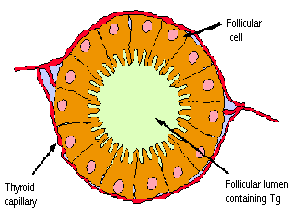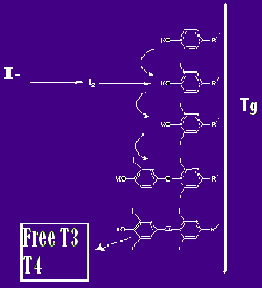
How is thyroxine produced?
The synthesis of thyroxine in the thyroid
gland takes place in the follicular cells and involves a number of steps:
1) The import of iodine into the cell
The import of iodine across the cell membrane is by an active transport mechanism as it goes against a steep concentration gradient (iodide concentration is much greater inside the cell than outside). The intake of iodide into the cell is ATP dependent and the iodide is transported in as NaI. The thyroid cells are the only cells in the body that will absorb iodine.
2) The iodination of tyrosine
The tyrosine in the thyroid cells is found
in thyroglobulin, Tg. Thyroglobulin is a protein which is contained
in the lumen of the thyroid cell; with a molecular weight of about 660000gmol-1,
it contains 300 carbohydrates and 5500 amino acids which include 140 tyrosines,
however only two to five of these tyrosines will be converted to T3
or T4.
The iodination occurs using thyroid peroxidase enzymes whilst the tyrosine is still attached to the rest of the thyroglobulin by peptide bonds.
3) The release of the thyroid hormones
TSH stimulates the release of T3 and T4 from thyroglobulin. The ratio of T4 to T3 produced in the thyroid is 4:1. Although all the bodies T4 is produced in the thyroid T3 can be derived from deiodination of T4 in other tissues such as the liver or the kidney, this process releases iodide back in to the body.